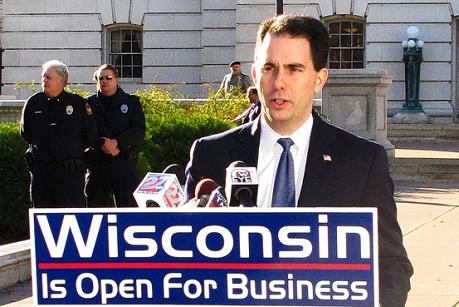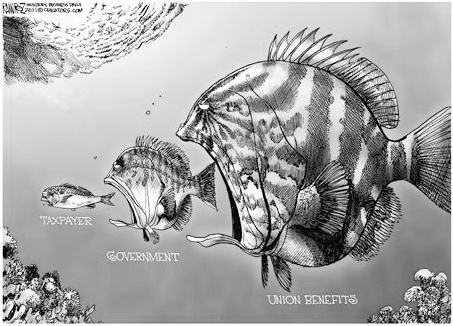Reforms Working in Wisconsin
Wisconsin Gov. Scott Walker is touting a new survey of Wisconsin School District administrators that shows his reforms are working for children, teachers and taxpayers.

Wisconsin Gov. Scott Walker is touting a new survey of Wisconsin School District administrators that shows his reforms are working for children, teachers and taxpayers.

Barack Obama is an effective president, unfortunately not of the United States but of the SEIU argues Arizona Gov. Jan Brewer: Unions — particularly public-employee unions — support illegal immigration because it serves their interests to have a permanent class of people who are financially dependent on the government. The sad secret about private-sector unions is that they are dying. All they do now is drive up the cost of doing business, thereby preventing their own members from getting hired. Arizona is what we call a “right to work” state. As mandated by the Arizona Constitution, Arizonans are free to join a union or not — it’s their choice, not some union boss’s command. And interestingly enough, when employees are given the choice of whether or not to join a union, they increasingly say no. These workers understand that the rigid workplace rules and regulations that unions promote are bad for growth, bad for competitiveness, and bad for jobs. More and more workers recognize this. That’s why in the private sector, where employees have a real stake in the success of the businesses they work for, only 7.5 percent of workers are unionized. By contrast, more than 36 percent of public-sector workers are unionized, and more than 42 percent of local-government workers. That’s because public-sector workers in the federal government don’t have to worry about unemployment. Ever. In many federal agencies, the primary threat to job security is actually death. Democratic-party bosses love government workers because each of those workers must rely upon the health and growth of government to pay his salary and guarantee his benefits. If the government contracts or shuts down for any reason, those workers are out of a job. And public-sector unions love the Democratic bosses because they keep on growing government. The more people the Democrats can put on the payroll, the more voters they can lock up for their candidates. That gives public-sector unions like the SEIU (which includes huge numbers of public employees) unbelievable leverage. Because the party bosses want to keep government workers employed and happy, they’ll give the unions just about anything they want. And the best part (for them) is that it doesn’t cost them a thing. The taxpayers pick up the tab. Liberal politicians spend taxpayer money to grow government; the unions keep voting for (and contributing to) Democrats, and the Democrats stay in office so they can spend more of the taxpayers’ money growing government. It’s a simple, corrupt, mutual back-scratching circle. How does illegal immigration play into this? Most illegal aliens work hard. That is not in dispute. But the unfortunate fact is that most illegal aliens are also unskilled and uneducated. Unskilled workers have higher unemployment rates and lower earnings. Many rely on government programs to help support them and their families. Much of this access to the welfare system by these households is gained through their American-born children, who are U.S. citizens. That means more government, which means more public-sector-union members. Even if, in the short term, more illegal immigration means fewer union jobs, the unions are okay with that. It is a strategic cost they are willing to bear. Because they know that if the Democrats keep winning, they will give the unions subsidies, grow government, and employ more union members.
President Obama continues to push a bailout for teacher’s union but it seems clear that in Oakland, there are at least 15% too many teacher’s. How else could 300 teachers, about 15% of all teacher’s,…
President Obama continues to push a bailout for teacher’s union but it seems clear that in Oakland, there are at least 15% too many teacher’s. How else could 300 teachers, about 15% of all teacher’s,…

In New York state, a teacher who showed up late for class 101 times in a single school year and left early 47 times is still on the job. Thanks to the monopoly bargaining power of the teacher’s union, she…

Forced-dues continue to fill the coffers of unions, as well as, union presidents' and politicians' pockets according to this recent study by the Commonwealth Foundation: Government Unions and Forced Dues Almost half of government workers in Pennsylvania are union members, compared to 9.3 percent in the private sector. Pennsylvania is a forced union state, meaning that workers can be forced to join a union or pay a [so-called] "fair share fee" just to keep their job. Most government units in Pennsylvania are "agency shops," with a specified union to which workers must pay a fee. When state and local governments automatically deduct dues and fair share fees from government workers' paychecks—as is the practice in Pennsylvania—employees have little or no say in how their money is used. Union Bosses Union bosses collect hefty salaries derived from member dues and fair share fees. In most cases, the salaries are several times the average union member's annual pay. While acknowledging that budgets were tight, AFSCME Council 13 President David Fillman got a 6 percent raise in 2010, making his salary higher than Gov. Tom Corbett's. Dues and fees often go towards expensive conferences, outings and junkets. For example, in 2009-10 the Pennsylvania State Education Association—the state's largest public sector union—spent: More than $250,000 on a board of directors retreat in Gettysburg. More than $89,000 for a "political institution meeting" at the Radisson Penn Harris in Camp Hill, Pa. $20,000 for advertising in the Pittsburgh Steelers Yearbook. Almost $5,900 at Kimberton Golf Club and more than $5,100 at Concord Country Club in Chadd's Ford. Political Activity and Lobbying

Forced-dues continue to fill the coffers of unions, as well as, union presidents' and politicians' pockets according to this recent study by the Commonwealth Foundation: Government Unions and Forced Dues Almost half of government workers in Pennsylvania are union members, compared to 9.3 percent in the private sector. Pennsylvania is a forced union state, meaning that workers can be forced to join a union or pay a [so-called] "fair share fee" just to keep their job. Most government units in Pennsylvania are "agency shops," with a specified union to which workers must pay a fee. When state and local governments automatically deduct dues and fair share fees from government workers' paychecks—as is the practice in Pennsylvania—employees have little or no say in how their money is used. Union Bosses Union bosses collect hefty salaries derived from member dues and fair share fees. In most cases, the salaries are several times the average union member's annual pay. While acknowledging that budgets were tight, AFSCME Council 13 President David Fillman got a 6 percent raise in 2010, making his salary higher than Gov. Tom Corbett's. Dues and fees often go towards expensive conferences, outings and junkets. For example, in 2009-10 the Pennsylvania State Education Association—the state's largest public sector union—spent: More than $250,000 on a board of directors retreat in Gettysburg. More than $89,000 for a "political institution meeting" at the Radisson Penn Harris in Camp Hill, Pa. $20,000 for advertising in the Pittsburgh Steelers Yearbook. Almost $5,900 at Kimberton Golf Club and more than $5,100 at Concord Country Club in Chadd's Ford. Political Activity and Lobbying

The experience of state after state shows that public-sector compulsory unionism as well as private-sector compulsory unionism devours job- and income-creating opportunities for taxpaying businesses and employees. Credit: Michael Ramirez/Investors Business Daily Union Bosses Aim to Kill Recent Buckeye State Reform Next Month (Source: October 2011 NRTWC Newsletter) Over the past decade, the citizens of forced-unionism Ohio have been afflicted with one of the worst-performing state economies in the country. Across the U.S. as a whole, despite the severe recent recession, private employers' inflation-adjusted outlays for employee compensation (including wages, salaries, bonuses and benefits) did increase from 2000 to 2010, by an average of 4.3%. And many states fared much better than that. In the 22 states with Right to Work laws on the books protecting both private- and public-sector employees from being fired for refusal to pay dues or fees to an unwanted union, real private-sector employee compensation grew by an aggregate 11.3%. Private employees in 20 of the 22 Right to Work states experienced 2000-2010 compensation growth greater than the national average. Unfortunately, in the 28 states without Right to Work laws on the books, private-sector outlays for employee compensation rose only by a combined 0.7%, after adjusting for inflation. Thirteen of the 14 states with the lowest compensation growth lack a Right to Work law. Ohio was one of just five states with negative real private-sector compensation growth over the last decade. In 2010, Ohio's business expenditures for private employee compensation were 6.6% less than they had been in 2000. Region, Job Mix Can't Account For Buckeye State's Shrinking Private Employee Compensation When confronted with such data, apologists for the forced-unionism policies that prevailed across the board in Ohio for decades until this year try to explain them away by blaming the Buckeye State's location in the U.S. Midwest or its historically high manufacturing density for its abysmal economic record. But such excuses won't wash.

The experience of state after state shows that public-sector compulsory unionism as well as private-sector compulsory unionism devours job- and income-creating opportunities for taxpaying businesses and employees. Credit: Michael Ramirez/Investors Business Daily Union Bosses Aim to Kill Recent Buckeye State Reform Next Month (Source: October 2011 NRTWC Newsletter) Over the past decade, the citizens of forced-unionism Ohio have been afflicted with one of the worst-performing state economies in the country. Across the U.S. as a whole, despite the severe recent recession, private employers' inflation-adjusted outlays for employee compensation (including wages, salaries, bonuses and benefits) did increase from 2000 to 2010, by an average of 4.3%. And many states fared much better than that. In the 22 states with Right to Work laws on the books protecting both private- and public-sector employees from being fired for refusal to pay dues or fees to an unwanted union, real private-sector employee compensation grew by an aggregate 11.3%. Private employees in 20 of the 22 Right to Work states experienced 2000-2010 compensation growth greater than the national average. Unfortunately, in the 28 states without Right to Work laws on the books, private-sector outlays for employee compensation rose only by a combined 0.7%, after adjusting for inflation. Thirteen of the 14 states with the lowest compensation growth lack a Right to Work law. Ohio was one of just five states with negative real private-sector compensation growth over the last decade. In 2010, Ohio's business expenditures for private employee compensation were 6.6% less than they had been in 2000. Region, Job Mix Can't Account For Buckeye State's Shrinking Private Employee Compensation When confronted with such data, apologists for the forced-unionism policies that prevailed across the board in Ohio for decades until this year try to explain them away by blaming the Buckeye State's location in the U.S. Midwest or its historically high manufacturing density for its abysmal economic record. But such excuses won't wash.